|
An extract from "Walking Northern
Railways", (Vol Two, West) by Charlie Emett, courtesy of Cicerone
Press.
Length: 11 Miles
Opened: For passenger traffic-2nd August, 1869 and goods
traffic 1st March, 1870
Closed: For goods and passenger traffic- January 1970
O/S: Sheets 109/118 (Landranger) or Pathfinder 741/759
'No poetry in railways!' foolish thought
of a dull brain, to no fine music wrought.
Charles Mackay.
|
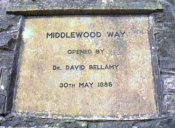 'Tewiffic!'
enthused Dr David Bellamy, jumping for joy at the new walkway. The occasion was the
official opening of the Middlewood Way on May 30th 1985 at Higher Poynton station, now a
beautifully landscaped picnic area. David, as the botanic man insisted on being called,
unveiled a plaque there, further marked his presence with a tree planting ceremony and
delighted onlookers and councillors alike by removing his shoes and socks and wading
through a mucky pond. Bubbling over with approbation, bearded Bellamy was clearly
impressed with the Middlewood Way and lavished praise on the Stockport and Macclesfield
councils who, with D.O.E. grants of £1.3 million have done such a fine job reclaiming the
derelict railway track and turning it into a nature treasure trail.
'Tewiffic!'
enthused Dr David Bellamy, jumping for joy at the new walkway. The occasion was the
official opening of the Middlewood Way on May 30th 1985 at Higher Poynton station, now a
beautifully landscaped picnic area. David, as the botanic man insisted on being called,
unveiled a plaque there, further marked his presence with a tree planting ceremony and
delighted onlookers and councillors alike by removing his shoes and socks and wading
through a mucky pond. Bubbling over with approbation, bearded Bellamy was clearly
impressed with the Middlewood Way and lavished praise on the Stockport and Macclesfield
councils who, with D.O.E. grants of £1.3 million have done such a fine job reclaiming the
derelict railway track and turning it into a nature treasure trail.
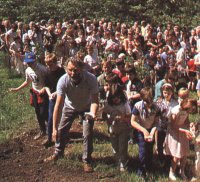 The next day, together with Steven Barker,
who has accompanied me on countless walks, I saw for myself just what made the Middlewood
Way so special and learned something of the problems facing the North Staffordshire
Railway and the Manchester, Sheffield and Lincolnshire when they combined to build the
Macclesfield, Bollington and Marple line in the early 1860's.
The next day, together with Steven Barker,
who has accompanied me on countless walks, I saw for myself just what made the Middlewood
Way so special and learned something of the problems facing the North Staffordshire
Railway and the Manchester, Sheffield and Lincolnshire when they combined to build the
Macclesfield, Bollington and Marple line in the early 1860's.
As far back as 1849 the North Staffordshire Railway, (N.S.) having reached Macclesfield,
found the way to Manchester blocked by the ever-jealous London and North Western Railway,
(L.N.W.) The N.S. therefore suggested a branch to Whaley Bridge to link with the proposed
Manchester, Sheffield and Lincolnshire Railway, (M.S.L.) from Hyde Junction; but nothing
came of it. Throughout, the L.N.W. was obstructive and refused to allow any traffic to
Manchester to pass via Macclesfield, insisting that it went via Crewe, thus ensuring a
greater L.N.W. mileage.
In 1863 a Macclesfield businessman, Thomas Oliver, in an effort to give a fresh lease of life
to Bollington, then an important cotton town suffering depression due to the American
civil war, promoted a scheme for a local line to be built from Macclesfield to Marple via
Bollington. The line would also carry Kerridge stone from local quarries and coal from the
collieries of the Poynton area.
Both
the N.S. and the M.S.L. were enthusiastic about the scheme, the N.S. because it could
become a new route to Manchester independent of the L.N.W., which was becoming
increasingly obstructive; and the M.S.L. who saw it as an other outlet to the south. The
Macclesfield
Courier and Herald proclaimed M.S.L.'s enthusiastic General Manager, Edward Watkin, to
be the inspired leader of the scheme, second only to Thomas Oliver. With such support the
scheme prospered and the line was authorised on 14th July 1864. The N.S. and the M.S.L.
were both empowered to subscribe £80,000 for its construction and work it when open. Yet
almost immediately the original purpose of the line to provide the N.S. with an
independent route to Manchester was lost because the L.N.W., alarmed at the success of the
M.B.M. came to an amicable traffic agreement with the N.S.
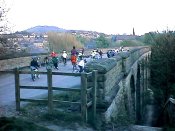 Now
that the urgency had gone out of the scheme the construction of the line slowed
considerably despite there being no major engineering problems apart from a low, 23 arch
viaduct at Bollington and two deep cuttings on the approach to Marple Wharf Junction.
When, at long last, it opened for passenger traffic on 2nd August 1869, the M.B.M. was
single line only, on the 'up' side of a double bed. Four single platform stations, Marple
Rose Hill, High Lane, Poynton and Bollington served it. Initially there were four trains
each way on weekdays and two each way on Sundays. Goods depots were opened at Rose Hill
and Bollington and a goods service began on 1st March 1870.
Now
that the urgency had gone out of the scheme the construction of the line slowed
considerably despite there being no major engineering problems apart from a low, 23 arch
viaduct at Bollington and two deep cuttings on the approach to Marple Wharf Junction.
When, at long last, it opened for passenger traffic on 2nd August 1869, the M.B.M. was
single line only, on the 'up' side of a double bed. Four single platform stations, Marple
Rose Hill, High Lane, Poynton and Bollington served it. Initially there were four trains
each way on weekdays and two each way on Sundays. Goods depots were opened at Rose Hill
and Bollington and a goods service began on 1st March 1870.
In 1871 the line was doubled throughout at a cost of £16,000 and second platforms were
provided at all four stations. By 1872 a link had been made just north of Poynton station
with Lord Vernon's colliery railway system, the line curving westwards in a wide arc to
enter the colliery. A great deal of traffic was carried along this branch to and from the
M.B.M. until the last colliery closed in 1935.
The
original Macclesfield terminus was a temporary one sited close to the L.N.W. Hibel Road
station. For two years the M.S.L. General Manager tried to persuade the L.N.L. to partner
the N.S. and M.S.L. in building a station to serve all three lines but the ever suspicious
L.N.W. refused to consider it. Faced with the L.N.W.'s interminable intransigence the N.S.
and M.S.L. opted to go ahead without their problem rival. Together they built a link from
the M.B.M. to join the N.S. main line a little south of Hibel Road station. It was opened
in 1873 and the original terminus near the L.N.W. Hibel Road station became a goods depot.
Still the L.N.W. remained obdurate and refused to allow any through N.S.-L.N.W. trains to
use the new joint station, the Central. This decision meant that both the Central station
and the M.B.M. line were deprived of much of the connectional usefulness; and the M.B.M.
settled down to a purely local existence.
A bridge carried the M.B.M. line over L.N.W 's Stockport-Buxton line at the northern end of
the L.N.W. Middlewood station. In early 1879 the M.B.M. authorities opened a station
almost directly above the L.N.W. Middlewood station for the interchange of passengers.
Earlier, in 1876, a curve connecting these two lines to provide better facilities between
Macclesfield and Buxton had been proposed; but it did not materialise until 1885.
It was an elaborate affair of the type normally only found at the most important and busiest
of junctions. It contained a flyover, which carried the 'down' line from Macclesfield over
the Buxton line to link with the 'up' line to Buxton, so avoiding problems with down
Buxton trains. It was the only 'flying' junction on the south side of Manchester. High
hopes were expected of it but the curve was not a great success and soon services along it
were confined to the summer months. However, through goods trains used the curve regularly
and exchange sidings were added. A daily early morning goods train from Macclesfield to
Buxton used the curve. It was known as the 'knotty' after the nickname of the N.S. which
used the Staffordshire knot as its company badge. It ran until after the Second World War
and when it ceased the curve was used mainly for storing old coaches.
From
Marple Rose Hill the M.B.M. flanked the Pennines all the way to Macclesfield. Its stations
were all small and unpretentious. Initially Rose Hill, situated on the 'up' side of the
line, comprised a small, one story brick building with a low pitched slate roof which
extended to form a canopy. Inside were four rooms, all entered from the platform - the
Porter's Room, the Station Office, a General Waiting Room - come - Booking Office and a
Ladies Waiting Room and lavatory. A brick built gents, adjoined. As business expanded
greater facilities were called for and a similar office block was built on the 'down'
side.
When
Rose Hill station was built the only house in site was the Railway Inn but soon afterwards
houses began to be built more on the Rose Hill side of Marple. Not until after the first
World War was the area around the station developed. High Lane was built on the Stockport
- Buxton turnpike road half a mile away from the little settlement from which it took its
name. It was surrounded by fields then: it remains surrounded by fields today. It really
was out in the sticks. Gas lighting never reached High Lane and it remained oil lit until
the 1970's. There were no houses at Middlewood, which really was situated in the middle of
a wood, with no road access. There was little local traffic but a fair amount of toing and
froing between the M.C.M. High Level and the L.N.W. Low Level stations.
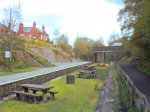 The Middlewood Way is certainly one of the
finest examples of skilful conversion of a derelict line that I have come across and much
of the credit must go to the Macclesfield Groundwork Trust - motto: Linking Town…
With Country - which provided so much expertise. In three brief years the line as far
as Bollington has been transformed from an eyesore to a most pleasing trail which provides
excellent walking, riding and cycling facilities well away from road traffic. Stout fences
separate the bridlepath from the path used by cyclists and walkers. Within the sheltered
cuttings there is a choice of routes for all but horse riders. You can either keep to the
cutting bottom or, should you prefer it, take either of the paths built along the tops of
the embankments from where right along the route, there are always fine views of the
Cheshire Plain, the urban skyline and the
The Middlewood Way is certainly one of the
finest examples of skilful conversion of a derelict line that I have come across and much
of the credit must go to the Macclesfield Groundwork Trust - motto: Linking Town…
With Country - which provided so much expertise. In three brief years the line as far
as Bollington has been transformed from an eyesore to a most pleasing trail which provides
excellent walking, riding and cycling facilities well away from road traffic. Stout fences
separate the bridlepath from the path used by cyclists and walkers. Within the sheltered
cuttings there is a choice of routes for all but horse riders. You can either keep to the
cutting bottom or, should you prefer it, take either of the paths built along the tops of
the embankments from where right along the route, there are always fine views of the
Cheshire Plain, the urban skyline and the 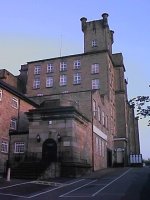 Pennine
foot-hills. Bridges have been repaired, more than 28,000 shrubs and 8,000 trees have been
planted and miles of ditches dug.
Pennine
foot-hills. Bridges have been repaired, more than 28,000 shrubs and 8,000 trees have been
planted and miles of ditches dug.
The
five evenly spaced picnic areas attract a lot of people, many of whom are content to sit
at the stout tables provided, eat their sandwiches, drink their beverages and watch the
passing parade. Nothing much happens at these places but many people come and go. The walk
attracts walkers and cyclists in roughly the same numbers. People on horseback are thinner
on the ground. Yet because the Middlewood way slices through 'Horsey' country the
bridle-way is seldom devoid of equestrians; and this is as it should be.
There
are car parks at Rose Hill, High Lane, Higher Poynton and below the viaduct at Bollington.
The
Macclesfield canal, meandering gracefully through the Pennine foot-hills roughly parallel
to the Middlewood Way, makes an interesting divertisement. To the left or Bollington side
of the bridge leading from Tinkers Clough wood stands the huge Adelphi Mill, a proud
reminder of the town's strong association with cotton. Adjacent to the bridge, on the far
side of the canal, two luxurious dwellings enhance the site of the converted mill, the Bee
Hive. What a delight these superior houses are and how well they blend with their restful
surroundings.
 Perched
on a hilltop overlooking Bollington is a white landmark, a folly, called white nancy. The
origin of the name is obscure but the three likeliest explanations all have merit. (1)
There used to be an ordnance column on the site and Nancy is a corruption of the 'nance'
part of ordnance. (2) Both Mrs. Gaskell, wife of the folly's builder and her daughter were
called Nancy. (3) The lead horse of a team of eight used to drag a heavy marble table
uphill to be placed inside the folly was called Nancy. You can take your choice! The table
is still there. Once access to it was through an oak-studded door but because of a very
real fear that vandals would damage it, the folly's entrance was sealed with the table
still inside.
Perched
on a hilltop overlooking Bollington is a white landmark, a folly, called white nancy. The
origin of the name is obscure but the three likeliest explanations all have merit. (1)
There used to be an ordnance column on the site and Nancy is a corruption of the 'nance'
part of ordnance. (2) Both Mrs. Gaskell, wife of the folly's builder and her daughter were
called Nancy. (3) The lead horse of a team of eight used to drag a heavy marble table
uphill to be placed inside the folly was called Nancy. You can take your choice! The table
is still there. Once access to it was through an oak-studded door but because of a very
real fear that vandals would damage it, the folly's entrance was sealed with the table
still inside.
Although
the Middlewood Way, certainly from Marple to Bollington, looks complete, the Macclesfield
Borough Council and Stockport 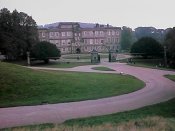 Metropolitan Borough Council say that other
facilities will be added as opportunities arise; and that, as with the work already done,
in future work, the ranger and warden services will be the key to progress.
Metropolitan Borough Council say that other
facilities will be added as opportunities arise; and that, as with the work already done,
in future work, the ranger and warden services will be the key to progress.
Strong
as is the Ways great appeal, it holds yet another valuable asset in the number of
alternative routes and circular walks it provides. The Ladybrook Valley Walk bisects the
Way at Middlewood station while close to Higher Poynton are to be found the old tramways
of the Poynton colliery inclines. Still at Higher Poynton an interesting uphill walk to
southwards along a quiet country road leads, after a couple of miles, to magnificent Lyme
Hall in the middle of Lyme Country Park. Roaming this undulating parkland is a large herd
of red deer. Close to Lyme Hall the Gritstone Trail begins its tortuous journey, skirting
the Pennines roughly parallel to but much higher up than the Middlewood Way. Much closer
to the Way and again roughly parallel to it is the Macclesfield Canal.
|
Special thanks to Charlie Emett and
Cicerone Press for their permission to display this extract. The Web-Author would also
like to thank Christopher Thompson of Hazel Grove, a railway walks enthusiast, who
identified its suitability for inclusion on the site and followed through by contacting
the author and publisher. The photographs of Bollington Viaduct, Adephi Mill, White Nancy
and Lyme Hall are by Chris, the remaining images have been added by
web-author, Mark Whittaker.
|
|
This book, about the line that used to run
along the Way, comes highly recommended by Chris Thompson, here's what he has to
say about it:
Railways
of Macclesfield and the Line to Bollington, Poynton and Marple (Rose
Hill)
Basil Jeuda / Publisher Foxline - 1995
 Written to commemorate
the 150th Anniversary of rail reaching Macclesfield in 1845, with
over fifteen years of research, the author has attempted to portray
not only the aspects of town life but also the railway's effect on
the industrial prosperity of Macclesfield, Bollington, Poynton and
Marple. Written to commemorate
the 150th Anniversary of rail reaching Macclesfield in 1845, with
over fifteen years of research, the author has attempted to portray
not only the aspects of town life but also the railway's effect on
the industrial prosperity of Macclesfield, Bollington, Poynton and
Marple.
The book offers a
historical and pictorial journey departing from Macclesfield's Hibel
Road Station to Macclesfield Central then Bollington, Higher
Poynton, Middlewood, High Lane and arriving at Marple Rose Hill. All
stations on route are fully illustrated with various pictures taken
between 1905 to 1970. Over 200 photographs guide you along a journey
through time.
The last train
departed from Macclesfield at 10.31 p.m. on Saturday 3rd January
1970 bound for Manchester Piccadilly. But you don't have to be
mad about trains to enjoy this book! You might prefer to study the
ever changing fashions, distant landmarks or even platform
advertisements, timetables and tickets. Many buildings and housing
estates are clearly visible in the background - will you recognise
anything?
If you don't want
to buy on-line and live local to
Marple you can obtain a copy of the book from the bookstore at
Brookside Garden Centre, Poynton (Please check availability).
Alternatively you can contact the publishers directly, see below.

Chris also says
about Foxline Publishing:
I have been searching
for photographs of several dismantled railways in the area for a
considerable time, with little success. Even specialist Internet web
sites seem unable to obtain information and pictures of specific
local interest.
I am now very pleased
to be able to recommend a superb selection of books, published
locally by Foxline Publications (Romiley, Stockport). Foxline offer
an extensive range of railway enthusiasts' books containing rare
photographs plus historical and local information provided by local
authors. Whatever your interest, steam, diesel, nostalgia, or local
"period" photo's, they will probably have what you
require. If you are interested, then contact Foxline for details of other titles, postage rates for the UK and
overseas etc. For a comprehensive list of all available titles
please send a SAE or telephone…
Foxline Publishing (Telephone
0161 430 6834)
32 Urwick Road
Romily
Stockport
Cheshire
SK6 3JS
Also by Basil
Jeuda
Macclesfield, Bollington and Marple Railway Foxline 1983
|
 'Tewiffic!'
enthused Dr David Bellamy, jumping for joy at the new walkway. The occasion was the
official opening of the Middlewood Way on May 30th 1985 at Higher Poynton station, now a
beautifully landscaped picnic area. David, as the botanic man insisted on being called,
unveiled a plaque there, further marked his presence with a tree planting ceremony and
delighted onlookers and councillors alike by removing his shoes and socks and wading
through a mucky pond. Bubbling over with approbation, bearded Bellamy was clearly
impressed with the Middlewood Way and lavished praise on the Stockport and Macclesfield
councils who, with D.O.E. grants of £1.3 million have done such a fine job reclaiming the
derelict railway track and turning it into a nature treasure trail.
'Tewiffic!'
enthused Dr David Bellamy, jumping for joy at the new walkway. The occasion was the
official opening of the Middlewood Way on May 30th 1985 at Higher Poynton station, now a
beautifully landscaped picnic area. David, as the botanic man insisted on being called,
unveiled a plaque there, further marked his presence with a tree planting ceremony and
delighted onlookers and councillors alike by removing his shoes and socks and wading
through a mucky pond. Bubbling over with approbation, bearded Bellamy was clearly
impressed with the Middlewood Way and lavished praise on the Stockport and Macclesfield
councils who, with D.O.E. grants of £1.3 million have done such a fine job reclaiming the
derelict railway track and turning it into a nature treasure trail. The next day, together with Steven Barker,
who has accompanied me on countless walks, I saw for myself just what made the Middlewood
Way so special and learned something of the problems facing the North Staffordshire
Railway and the Manchester, Sheffield and Lincolnshire when they combined to build the
Macclesfield, Bollington and Marple line in the early 1860's.
The next day, together with Steven Barker,
who has accompanied me on countless walks, I saw for myself just what made the Middlewood
Way so special and learned something of the problems facing the North Staffordshire
Railway and the Manchester, Sheffield and Lincolnshire when they combined to build the
Macclesfield, Bollington and Marple line in the early 1860's. Now
that the urgency had gone out of the scheme the construction of the line slowed
considerably despite there being no major engineering problems apart from a low, 23 arch
viaduct at Bollington and two deep cuttings on the approach to Marple Wharf Junction.
When, at long last, it opened for passenger traffic on 2nd August 1869, the M.B.M. was
single line only, on the 'up' side of a double bed. Four single platform stations, Marple
Rose Hill, High Lane, Poynton and Bollington served it. Initially there were four trains
each way on weekdays and two each way on Sundays. Goods depots were opened at Rose Hill
and Bollington and a goods service began on 1st March 1870.
Now
that the urgency had gone out of the scheme the construction of the line slowed
considerably despite there being no major engineering problems apart from a low, 23 arch
viaduct at Bollington and two deep cuttings on the approach to Marple Wharf Junction.
When, at long last, it opened for passenger traffic on 2nd August 1869, the M.B.M. was
single line only, on the 'up' side of a double bed. Four single platform stations, Marple
Rose Hill, High Lane, Poynton and Bollington served it. Initially there were four trains
each way on weekdays and two each way on Sundays. Goods depots were opened at Rose Hill
and Bollington and a goods service began on 1st March 1870.
 The Middlewood Way is certainly one of the
finest examples of skilful conversion of a derelict line that I have come across and much
of the credit must go to the Macclesfield Groundwork Trust - motto: Linking Town…
With Country - which provided so much expertise. In three brief years the line as far
as Bollington has been transformed from an eyesore to a most pleasing trail which provides
excellent walking, riding and cycling facilities well away from road traffic. Stout fences
separate the bridlepath from the path used by cyclists and walkers. Within the sheltered
cuttings there is a choice of routes for all but horse riders. You can either keep to the
cutting bottom or, should you prefer it, take either of the paths built along the tops of
the embankments from where right along the route, there are always fine views of the
Cheshire Plain, the urban skyline and the
The Middlewood Way is certainly one of the
finest examples of skilful conversion of a derelict line that I have come across and much
of the credit must go to the Macclesfield Groundwork Trust - motto: Linking Town…
With Country - which provided so much expertise. In three brief years the line as far
as Bollington has been transformed from an eyesore to a most pleasing trail which provides
excellent walking, riding and cycling facilities well away from road traffic. Stout fences
separate the bridlepath from the path used by cyclists and walkers. Within the sheltered
cuttings there is a choice of routes for all but horse riders. You can either keep to the
cutting bottom or, should you prefer it, take either of the paths built along the tops of
the embankments from where right along the route, there are always fine views of the
Cheshire Plain, the urban skyline and the  Pennine
foot-hills. Bridges have been repaired, more than 28,000 shrubs and 8,000 trees have been
planted and miles of ditches dug.
Pennine
foot-hills. Bridges have been repaired, more than 28,000 shrubs and 8,000 trees have been
planted and miles of ditches dug. Perched
on a hilltop overlooking Bollington is a white landmark, a folly, called white nancy. The
origin of the name is obscure but the three likeliest explanations all have merit. (1)
There used to be an ordnance column on the site and Nancy is a corruption of the 'nance'
part of ordnance. (2) Both Mrs. Gaskell, wife of the folly's builder and her daughter were
called Nancy. (3) The lead horse of a team of eight used to drag a heavy marble table
uphill to be placed inside the folly was called Nancy. You can take your choice! The table
is still there. Once access to it was through an oak-studded door but because of a very
real fear that vandals would damage it, the folly's entrance was sealed with the table
still inside.
Perched
on a hilltop overlooking Bollington is a white landmark, a folly, called white nancy. The
origin of the name is obscure but the three likeliest explanations all have merit. (1)
There used to be an ordnance column on the site and Nancy is a corruption of the 'nance'
part of ordnance. (2) Both Mrs. Gaskell, wife of the folly's builder and her daughter were
called Nancy. (3) The lead horse of a team of eight used to drag a heavy marble table
uphill to be placed inside the folly was called Nancy. You can take your choice! The table
is still there. Once access to it was through an oak-studded door but because of a very
real fear that vandals would damage it, the folly's entrance was sealed with the table
still inside. Metropolitan Borough Council say that other
facilities will be added as opportunities arise; and that, as with the work already done,
in future work, the ranger and warden services will be the key to progress.
Metropolitan Borough Council say that other
facilities will be added as opportunities arise; and that, as with the work already done,
in future work, the ranger and warden services will be the key to progress. Written to commemorate
the 150th Anniversary of rail reaching Macclesfield in 1845, with
over fifteen years of research, the author has attempted to portray
not only the aspects of town life but also the railway's effect on
the industrial prosperity of Macclesfield, Bollington, Poynton and
Marple.
Written to commemorate
the 150th Anniversary of rail reaching Macclesfield in 1845, with
over fifteen years of research, the author has attempted to portray
not only the aspects of town life but also the railway's effect on
the industrial prosperity of Macclesfield, Bollington, Poynton and
Marple.